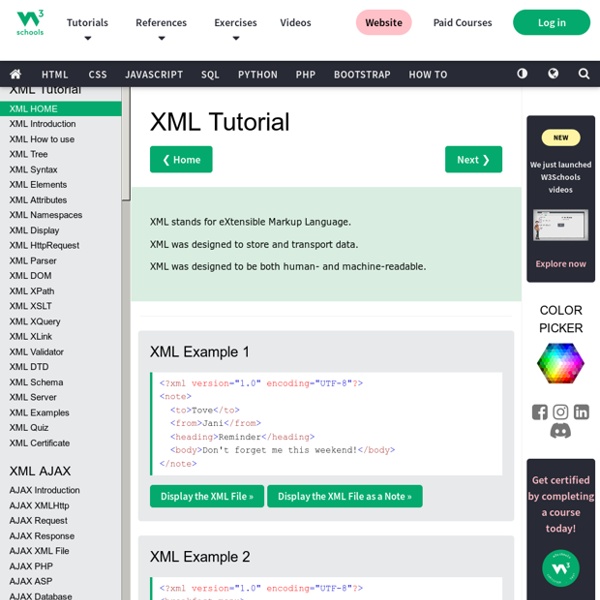



https://www.w3schools.com/xml/default.asp
Related: Coding_LECTURESWelcome to Jinja2 — Jinja2 Documentation (2.8-dev) Jinja2 is a modern and designer-friendly templating language for Python, modelled after Django’s templates. It is fast, widely used and secure with the optional sandboxed template execution environment: <title>{% block title %}{% endblock %}</title><ul>{% for user in users %} <li><a href="{{ user.url }}">{{ user.username }}</a></li>{% endfor %}</ul> Features: sandboxed executionpowerful automatic HTML escaping system for XSS preventiontemplate inheritancecompiles down to the optimal python code just in timeoptional ahead-of-time template compilationeasy to debug. Line numbers of exceptions directly point to the correct line in the template.configurable syntax Extensible Markup Language (XML) Nearby: XML Specifications and Translations of them. Introduction Extensible Markup Language (XML) is a simple, very flexible text format derived from SGML (ISO 8879). Originally designed to meet the challenges of large-scale electronic publishing, XML is also playing an increasingly important role in the exchange of a wide variety of data on the Web and elsewhere. This page describes the work being done at W3C within the XML Activity, and how it is structured.
XML - Managing Data Exchange Xania has nominated himself for use of the Checkuser tools. Please provide your input on this important decision. XML - Managing Data Exchange From Wikibooks, open books for an open world Jump to: navigation, search Create XML Schemas With The Simplest XML Editor Available Working with XML as text can be tricky, tedious and difficult. Why not use a tool that is specifically designed to edit, manipulate, and create XML files? PrimalXML is just that tool. Need to take a quick look at some XML data? Maybe you have to modify the structure of an XML file for another department. PrimalXML is here to help.
Where is the DirectX SDK? - Games for Windows and the DirectX SDK See also "Where is the DirectX SDK (2015 Edition)?" The DirectX SDK is now part of the Windows 8.0 SDK. The new Windows 8.0 SDK is where you’ll find DirectX 11.1, Direct2D, DirectWrite, DXGI 1.2, WDDM 1.2, DirectXMath, Feature Level 11.1 devices, XINPUT 1.4, XAUDIO 2.8, WIC2, the "Developer Runtime" (debugging layers and the REF device), and the latest HLSL compiler (D3DCompiler_*.DLL). Samples are now shipped online and can be found at the MSDN Code Gallery. We recommend using the Windows 8.x SDK instead of the DirectX SDK, or at a minimum using the Windows 8.x SDK primarily with only specific usages of the legacy DirectX SDK. XML .NET Remoting in Simple English (Really, it's that simple) Updated: 26 Jun 2003 This article is meant to be a step by step guide to give its reader a gist of .NET Remoting. This tutorial guides the reader to set up a fully functional chat program. VB, XML, Windows, .NET1.0, Dev
XML transformation language An XML to XML transformation An XML transformation language is a programming language designed specifically to transform an input XML document into an output document which satisfies some specific goal. There are two special cases of transformation: XML to XML: the output document is an XML document.XML to Data: the output document is a byte stream. XML to XML[edit] Local Storage You are here: Home Dive Into HTML5 Diving In Persistent local storage is one of the areas where native client applications have held an advantage over web applications. For native applications, the operating system typically provides an abstraction layer for storing and retrieving application-specific data like preferences or runtime state. These values may be stored in the registry, INI files, XML files, or some other place according to platform convention.